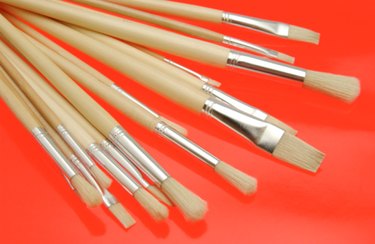
Paints may be oil based or water based, and you can mix different media in your art projects. Typically, it is safe to mix water-based colors such as acrylic paints, tempera, gouache colors or watercolors, but oil and water-based colors are not mixed in traditional painting. Mixing acrylic with oil paints can be an experiment, especially if you make abstract or mixed-media art.
Mixing Acrylic with Oil Paint
Video of the Day
Mixing two media such as acrylic and oil paint is like mixing water with oil; acrylic paints are water based and oil paints contain oil. Consequently, when mixing the two media, the oil separates from the acrylic colors because oil is less dense than water. Oil is a hydrophobic medium and won't dissolve in water-based paints because the water molecules bind with other water molecules that have a similar density, rather than with the hydrophobic molecules present in oil. The oil also dries slower than the acrylic paints. Christel Minotti is a Finnish painter who makes mixed-media paintings and mixes acrylic with regular oil paints. However, mixing oil with acrylic colors is not recommended for paintings that require a great deal of detail and precision, such as realistic portrait painting. You may experiment by mixing these media if you make abstract paintings or mixed-media art.
Video of the Day
Water-Soluble Oil Paints
Oil and water-based colors are not typically mixed, because the oil separates from water. However, if the components of the oil paints are chemically modified and you use water soluble or water mixable oil paints, you can mix your colors with acrylic or other water-based paints. The modified oil paints don't require turpentine or other solvents that are toxic. Water is used as a thinner for modified oil paints.
Acrylic Over Oil Surface
Avoid applying acrylic colors on oil-painted surfaces because the acrylic paints won't adhere to the surface and the water-based paint is prone to peeling. The underlying oil can stain the acrylic colors. To be able to apply acrylic paints on a surface that is painted with oil colors, allow the oil to dry, sand the painting and apply a layer of gesso (gypsum mixed with white glue) on your canvas before using acrylic colors.
Oil Over Acrylic Background
You may apply oil over a background that is covered in a thin layer of acrylic paint because the acrylic layer is porous and the oil adheres to the surface. However, you should apply oil over a surface painted with acrylic colors only after the paint is completely dry. The underlying layer of acrylic paint should be thin; a thick layer may cause the oil paints not to adhere properly due to the plastic compounds in the acrylic colors. A potential problem with oil applied over an acrylic background is that the paint may become brittle over time and is prone to cracks. To avoid the cracking of paint, sand the painting and prepare it with a layer of gesso prior to using oil paints.